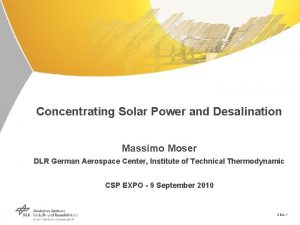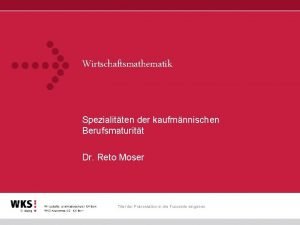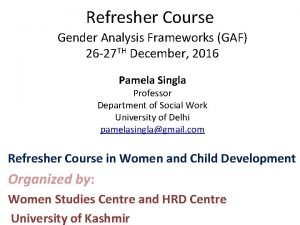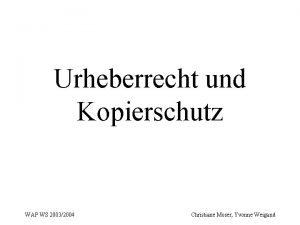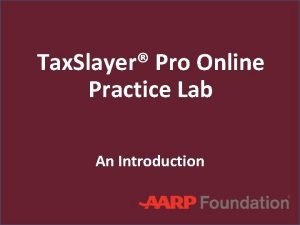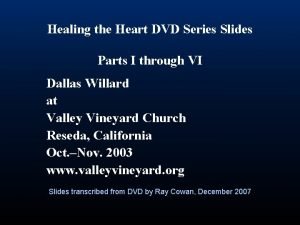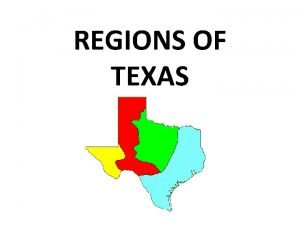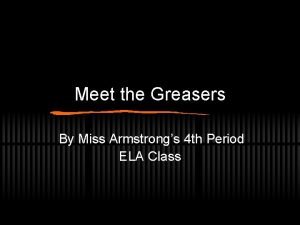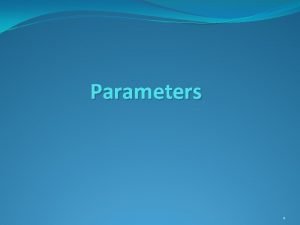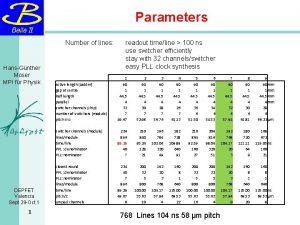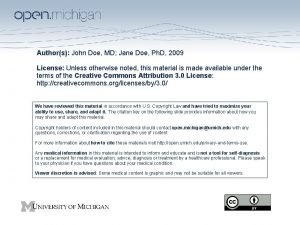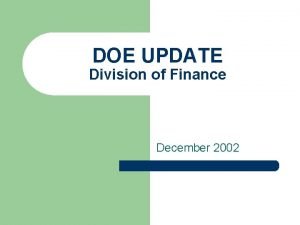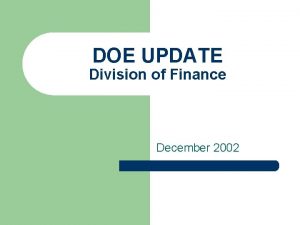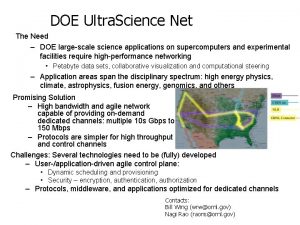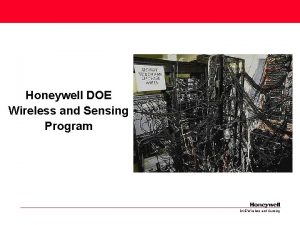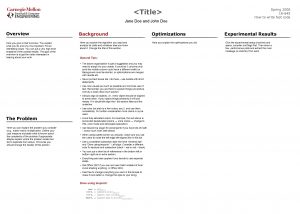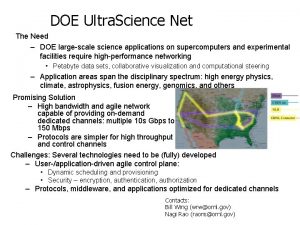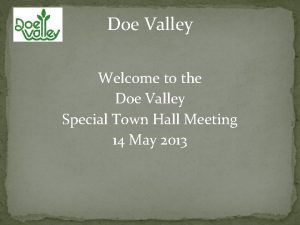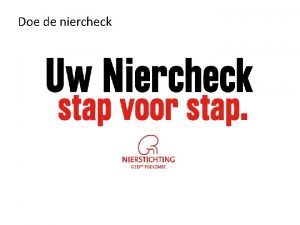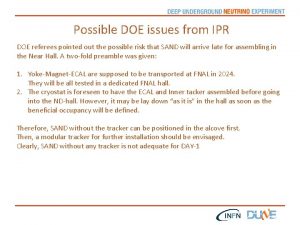MAGICMERV Nuclear Parameters Dallas Moser dallas mosercns doe







































- Slides: 39

MAGICMERV: Nuclear Parameters Dallas Moser dallas. moser@cns. doe. gov Nuclear Criticality Safety Engineer 1

Outline • Introduction to MAGICMERV • Mass • Absorption • Geometry • Interaction • Concentration • Moderation • Enrichment • Reflection • Volume 2

Introduction • What is MAGICMERV? – An acronym used to represent the most common nuclear parameters that influence criticality of fissile material • What does MAGICMERV stand for? • Mass • Absorption • Geometry • Interaction • Concentration • Moderation • Enrichment • Reflection • Volume • Are these all of the nuclear parameters of concern? – No, there are more nuclear parameters that can be considered in an evaluation. Examples? 3

Mass – Fissile Mass • What is it? – Represents the physical mass of fissile material (i. e. 350 g 235 U, 1 kg 239 Pu) • How does it work? – The lower the mass of fissile material, fewer fissile nuclei exist decreasing the likelihood that a neutron would interact with a fissile nuclei therefore reducing the probability of a fission • How does it effect reactivity? – Typically, more fissile mass leads to increased reactivity (higher keff). Examples where this is not true? • How often is this used as a controlled parameter? – Mass is often controlled as it’s easy to measure and understand, and directly effects neutron multiplication in a system • Concepts related to fissile mass: • Minimum critical mass • Subcritical mass limit • Assay uncertainty/ measurement uncertainty 4

Mass – Minimum Critical Mass and Subcritical Mass Limit • What is Minimum Critical Mass? – This is the lowest amount of fissile mass required for a unit/system to be critical (i. e. ~800 g for 93% enriched 235 U) • What is Subcritical Mass Limit? – This is simply the minimum critical mass with some added safety margin so that it can be used as a safety limit (i. e. 700 g for 235 U from ANSI/ANS-8. 1). LA-10860 -MS Figure 10 5

Mass – Measurement Uncertainty What is it? – No weight scale or detector is perfect, uncertainty in measurements should be taken into consideration during the analysis 6

Absorption – Neutron Absorbers • What is it? – Neutron absorbers are materials/atoms that have the potential to absorb a neutron without causing a fission (i. e. boron or cadmium). • How does it work? - Some isotopes present a neutron absorption cross section that allow neutrons to be absorbed without causing the nucleus to fission. These can also be referred to as “neutron poisons” because they typically reduce the neutron population. • How does it effect reactivity? – Loss of neutron absorbers typically leads to increased reactivity (higher keff). Examples where this is not true? • How often is this used as a controlled parameter? – Absorbers are often avoided, even if they are present in a system because their presence is difficult to verify, however increased rigor on procurement can make it more of a possibility • Concepts related to neutron absorbers: • Mild neutron absorbers versus strong neutron absorbers • Single unit versus array reactivity • How neutron energy effects absorbers 7

Absorption – Mild Absorbers • What are they? – Mild absorbers are as they sound, isotopes that provide a small probability of absorption. These type of absorbers are not usually intentionally placed into a system for the purpose of neutron absorption, but are often part of materials that are commonly used. • What are some examples of commonly found mild neutron absorbers? • Iron or aluminum – commonly found in many forms of steel used in drums, containers, or gloveboxes • Chlorine – Can be found in some plastics or chemicals • Fluorine – Can be found in some chemicals Al Cl Fe Interactive plot: https: //periodictable. com/Properties/A/Neutron. Mass. Absorption. html 8

Absorption – Strong Absorbers • What are they? – Strong absorbers present a significant absorptions cross section when compared to other elements/isotopes. These are not usually found in common materials of construction, but are intentionally put into a material for the purpose of neutron absorption • What are some examples of strong neutron absorbers? • Boron (most easily available) • Cadmium • Gadalinium B Cd Gd Samples of Borated Ceramic Used at Y 12 9

Absorption – Single Unit Versus Array Reactivity • What is single unit reactivity? – This is the reactivity with respect to neutron population of a single unit by itself • What is array reactivity? – This is the reactivity with respect to neutron population of several units placed near enough to each other such that neutrons from one unit can effect the neutron population of other nearby units. • How can the presence of neutron absorbers effect single unit reactivity? – Although neutron absorbers absorb neutrons, the effect is mostly seen if the absorber is present between fissile atoms, otherwise the neutron absorbers acts mostly as a scatterer, in which case single unit reactivity can increase if absorber is only present around the single unit • How can the presence of neutron absorbers effect array reactivity? – Arrays of units allows for absorbers to be placed between units where neutrons can be absorbed when travelling from one unit to another, decreasing array reactivity. 10

Absorption – Effects of Neutron Energy • What are the effects of neutron energy on absorption? – Just like any other cross section, absorption cross sections are dependent on neutron energy. Many of the absorption cross sections for strong neutron absorbers (i. e. boron) increase drastically when neutron energy is lower, therefore making it more effective • How can this be utilized? – This information can be used when designing poisoned systems by attempting to thermalize neutrons before it reaches the absorber so it can be more effective ceramic containing boron and water Description Single Unit Keff Large Array Keff 20 kg metal 0" dehydrated 0. 80611 0. 86382 20 kg metal 1" dehydrated 0. 79689 0. 86701 20 kg metal 2" dehydrated 0. 79443 0. 89262 20 kg metal full dehydrated 0. 79893 1. 09493 11

Geometry – The Fissile Shape • What is it? – Represents the physical shape of fissile material or the container that it is in • How does it work? – The physical geometry of fissile material will determine the neutron leakage of a system or how many neutrons can make it out of the fissile material without interacting. The surface area of a shape can be equated to neutron leakage, while the volume represents the amount of fissile material a geometry can hold, thus a system with a higher surface area to volume ratio will have more leakage. • How does it effect reactivity? – This depends, generally geometries with a higher surface area to volume ratio will be less reactive and vice versa • How often is this used as a controlled parameter? – Geometry is often controlled for containers (i. e. cylindrical) • Concepts related to geometry: • Commonly considered geometries • Typical containers and geometry limitations • Favorable versus unfavorable geometry 12

Geometry – Commonly Considered Geometries • What are they? – The most commonly considered geometries are: spheres, cylinders, and cuboids/slabs • What’s the difference? • Sphere: The most reactive single unit shape because it has the lowest surface area to volume ratio leading to the least amount of neutron leakage. • Cylinder: Typically considered the second most reactive single unit (depending on height to diameter (H/D) ratio). The lowest surface area to volume ratio for a cylinder is and H/D=1, however it is not the most reactive H/D. Most reactive is closer to H/D≈0. 92 shown by buckling. A very thin rod or very short height cylinder will have high leakage and low single unit reactivity. • Cuboidal/Slabs: Cubes often have the most leakage and offer the lowest single unit reactivity (depending on height, width, and length ratios). A very thin cube (slab) will have very high leakage and low reactivity. • Do these geometry reactivity assumptions apply to arrays? – Sometimes, yes, and other times, no. Putting units in arrays becomes a balancing act between single unit reactivity and interaction between units. Sometimes creating a geometry with more leakage can allow for more interaction in an array, causing an increase of reactivity. 13

Geometry – Typical Containers and Geometry Limitations • What is the typical container geometry? – Containers are typically cylindrical in nature, however they are often limited to a maximum height and maximum diameter. 14

Geometry – Favorable Versus Unfavorable • What is a favorable geometry? – This is a geometry that has inherently higher leakage, making it potentially safer than a geometry with lower leakage • What is an unfavorable geometry? – This is a geometry with inherently lower leakage, making it potentially more reactive than its low leakage counterpart Unfavorable Favorable Rod/Pipe Annulus Sphere Slab Large Tank 15

Interaction – Neutron Interaction Between Fissile Units • What is it? – Occurs when more than one fissile unit is present (not limited to discrete units) • How does it work? – Neutrons between physically separated fissile material can influence each other’s neutron population (i. e. neutrons from one unit can cause a fission in another physically separated unit and vice versa) increasing the overall reactivity of the system • How does it effect reactivity? – Typically, more interaction is more reactive, if units are spaced further apart, reactivity decreases. How the units are arranged (i. e. square or triangle pitch) can influence reactivity, stacking of units can influence reactivity, and the number of units interacting will effect reactivity. Examples where increased interaction may be worse? • How often is this used as a controlled parameter? – Interaction is often considered in analysis, even if it’s not explicitly controlled. Interaction includes topics such as: interaction with surrounding fissile processes, interaction with system hold up, and storage array • Concepts related to interaction: • Spacing and how it effects interaction • Physical controls on interaction 16

Interaction - Spacing • What is it? – Spacing is, as it sounds, the physical distance between fissile units 17

Interaction – Physical Controls • What are the typical physical controls? – These can be required spacers installed so that discrete units cannot be placed closer together. Often with containers and dollies, spacing is built into the design to decrease interaction between units in the container/dolly and between other containers/dollies. 18

Concentration – Fissile Material Concentration or Density • What is it? – Typically referencing the g fissile/L of solution or g fissile/cm 3 of metals or compounds • How does it work? – For dry compounds, lowering density introduces void space, for solution it introduces more moderation • How does it effect reactivity? – For dry compounds, lower density materials will be less reactive. If moderated, lower density solutions or compounds could be more reactive • How often is this used as a controlled parameter? – max concentration of solution and max density of oxides/other compounds is often credited in analysis 19

Concentration – Varying Density Materials 20

Moderation • What is it? – Introduction of some material that can effectively slow neutrons through multiple scatters • How does it work? – Neutrons lose energy when they scatter, more energy is lost per scatter if the nucleus is closer to the size of a neutron (i. e. hydrogen) • How does it effect reactivity? – Mixing fissile with a moderator will increase reactivity to an optimum, then it will decrease reactivity • How often is this used as a controlled parameter? – Moderation is often considered in analyses because it is so common (i. e. sprinklers, leaking pipes/roofs, oils, etc…) • Concepts related to Moderation: • Over-moderation versus under-moderation • Average logarithmic energy decrement • Moderating ratio 21

Moderation – Over-moderation Versus Under-moderation • What is over-moderation? – Fissile has been moderated so much that individual fissile atoms no longer interact • What is under-moderation? – Fissile has not been moderated enough to reach optimum Over-moderated Under-moderated Optimal 22

Moderation – Average Logarithmic Energy Decrement Symbol Meaning Scattered/average final neutron energy Symbol Meaning Average logarithmic energy decrement Incident/average initial neutron energy Mass of target or moderator nucleus Mass of incoming particle or neutron Atomic mass number of target 23

Moderation – Using Average Logarithmic Energy Decrement 24

Moderation – Average Logarithmic Energy Decrement Typical Values Examples of common elements Element A # Collisions 2 Me. V → 1 e. V H 1 1 15 D 2 0. 725 21 C 12 0. 158 92 O 16 0. 1199 121 Fe 56 0. 0353 412 238 U 238 0. 00838 1732 Decent website for reference: https: //www. nuclear-power. net/glossary/neutron-moderatoraverage-logarithmic-energy-decrement/ 25

Moderation – Fractional Energy Loss per Collision 26

Moderation – Macroscopic Slowing Down Power and Moderating Ratio DOE-HDBK-1019/1 -93 27

Enrichment – Fissile Isotope Percentage • What is it? – The percentage of fissile isotope in an element • How does it work? – Typically reported as weight percent (i. e. 20 wt% 235 U) • How does it effect reactivity? – Higher enrichment means more fissile atoms, which increases reactivity • How often is this used as a controlled parameter? – Most of the time, enrichment is evaluated at the highest possible, but is always considered in analysis 28

Reflection – Neutron Reflection • What is it? – Material that can scatter neutrons back into fissile material • How does it work? – Primary function is to scatter neutrons back into fissile material, good moderators are often good reflectors, however highly dense materials are also good reflectors (i. e. tungsten, lead, etc…) • How does it effect reactivity? – The addition of reflection is almost always more reactive • How often is this used as a controlled parameter? – Reflection is always considered in evaluations and often controlled for equipment like gloveboxes or situations that present more than nominal reflection (i. e. 1 inch of water) • Concepts related to Reflection: • What to consider in reflection • Effect of reflection versus moderation • Effectiveness of various reflectors • Effectively infinite (full) reflection 29

Reflection – What to Consider 30

Reflection – Reflection Versus Moderation What is the difference? Reflection changes critical mass by ~2 x Moderation by ~an order of magnitude ~20 -30 x change (moderation) ~2 x change (reflection) TID-7016 31

Reflection – Effectiveness of Various Reflectors TID-7016 32

Reflection – Effectiveness of Various Reflectors TID-7016 33

Reflection – Effectiveness of Various Reflectors TID-7028 34

Reflection – Effectively Infinite (Full) Reflection What is it? – Effectively infinite or full reflection is where the addition of more reflecting material causes a negligible change in reactivity Negligible change past this point (15 cm ~= 6 inch), 12 inches is often considered “full” water reflection LA-3612 35

Volume – Fissile Volume • What is it? – The physical volume fissile material can occupy • How does it work? – Larger containers can hold more fissile material (related to geometry) • How does it effect reactivity? – Larger volumes typically have potential to be more reactive • How often is this used as a controlled parameter? – Volume is often controlled along with mass and geometry 36

Example of Everything Together 37

Questions 38

DISCLAIMER This work of authorship and those incorporated herein were prepared by Consolidated Nuclear Security, LLC (CNS) as accounts of work sponsored by an agency of the United States Government under Contract DE‑NA‑ 0001942. Neither the United States Government nor any agency thereof, nor CNS, nor any of their employees, makes any warranty, express or implied, or assumes any legal liability or responsibility to any nongovernmental recipient hereof for the accuracy, completeness, use made, or usefulness of any information, apparatus, product, or process disclosed, or represents that its use would not infringe privately owned rights. Reference herein to any specific commercial product, process, or service by trade name, trademark, manufacturer, or otherwise, does not necessarily constitute or imply its endorsement, recommendation, or favoring by the United States Government or any agency or contractor thereof, or by CNS. The views and opinions of authors expressed herein do not necessarily state or reflect those of the United States Government or any agency or contractor (other than the authors) thereof. Copyright Notice This document has been authored by Consolidated Nuclear Security, LLC, a contractor of the U. S. Government under contract DE‑NA 0001942, or a subcontractor thereof. Accordingly, the U. S. Government retains a paid‑up, nonexclusive, irrevocable, worldwide license to publish or reproduce the published form of this contribution, prepare derivative works, distribute copies to the public, and perform publicly and display publicly, or allow others to do so, for U. S. Government purposes. 39
 Lesson 15 nuclear quest nuclear reactions
Lesson 15 nuclear quest nuclear reactions Fisión nuclear vs fision nuclear
Fisión nuclear vs fision nuclear Lucas moser
Lucas moser Components of harvard analytical framework
Components of harvard analytical framework Nolan moser
Nolan moser Manuela moser
Manuela moser Massimo moser
Massimo moser Ecole moser calendrier
Ecole moser calendrier Karl moser saatgut
Karl moser saatgut Reto moser
Reto moser Tori moser
Tori moser Moser gender planning framework
Moser gender planning framework Kathy moser
Kathy moser Christiane moser
Christiane moser Logisticare transportation texas
Logisticare transportation texas Taxslayerpro practice lab
Taxslayerpro practice lab Cfa austin
Cfa austin Dallas best robotics
Dallas best robotics Loop 9 dallas
Loop 9 dallas Dallas isd police
Dallas isd police Progressive era
Progressive era Utbtsc
Utbtsc Dallas west model
Dallas west model Dallas willard healing the heart
Dallas willard healing the heart Tams tracks
Tams tracks Carla morrow midwife
Carla morrow midwife Doing business in dallas
Doing business in dallas Jeyakesavan veerasamy
Jeyakesavan veerasamy Dr veerasamy dallas
Dr veerasamy dallas 4 regions of texas
4 regions of texas Veterinary radiology dallas county
Veterinary radiology dallas county Steve randles personality
Steve randles personality Texas museum of automotive history
Texas museum of automotive history Lake june head start
Lake june head start Federal reserve bank of dallas careers
Federal reserve bank of dallas careers The greasers personality traits
The greasers personality traits Paul kogut
Paul kogut Dallas interactive marketing
Dallas interactive marketing Dallas cert
Dallas cert Born on may 12, 1914, in dallas, texas.
Born on may 12, 1914, in dallas, texas.






